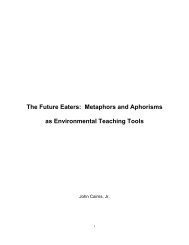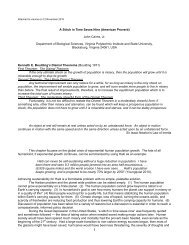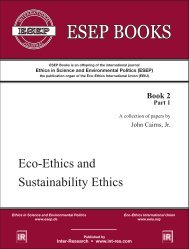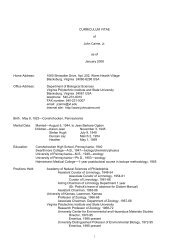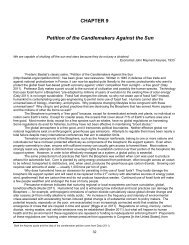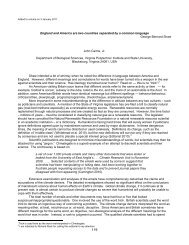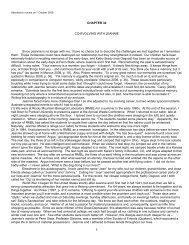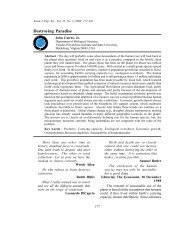View - ResearchGate
View - ResearchGate
View - ResearchGate
You also want an ePaper? Increase the reach of your titles
YUMPU automatically turns print PDFs into web optimized ePapers that Google loves.
Article 35295area one is familiar with is easier than caring for regions with which one has little contact. A classicliterary example of this sense of place is Thoreau’s Walden Pond.With the inspired leadership of local high school teacher Tom Furrer, a group of Casa GrandeHigh School students in Petaluma, California, raised money to clean up and restore Adobe Creek,which once had a salmon run (as described in Cairns 1999). Adopting a damaged ecosystem torestore would be a superb way for each community to develop a more harmonious relationshipwith natural systems. Such undertakings should involve all age groups, income levels and the like.In order to achieve sustainable use of the planet, all citizens must be able to understand the differencebetween self-regulating ecosystems, subsidized ecosystems, and damaged ecosystems.This knowledge alone will require massive participation and long-term commitment.Of course, all these efforts will be virtually useless if people limit their dedication to one particularecosystem while ignoring events in their bioregion. Of course, the interest level must not be trivial,e.g. one day a year is designated ‘Earth Day,’ in the United States—speeches are made, songsare sung, a few trees are planted; the next day is ‘business as usual.’ Ecosystem services areexpected to continue, but public involvement to protect the ecosystems that provide these servicesis not exemplary. Since the ecosystems constitute the planet’s ecological life-supportsystem, this lack of involvement is a flagrant denial of reality.CARRYING CAPACITYThe greatest peril to human society is seldom discussed. At its core is the concept of the planet’sfinite carrying capacity for humans. A related issue is what time human artifacts will displace naturalsystems to the point that they no longer furnish the ecosystem services essential to thesurvival of humankind. Reduction in ecosystem services will constitute a reduction in carryingcapacity. However great the displacement of natural systems by human artifacts, there is a strongprobability that natural systems will rediversify after an extinction, as has happened after previousmass extinctions. It is, therefore, not only an ethical responsibility to protect and restore naturalsystems, but it is also an act of enlightened self-interest since natural systems constitute humankind’slife-support system. In short, humankind needs natural systems, but they do not needhumans since natural systems existed for billions of years before humans arrived.Surprisingly, although human society does not appear to be deeply concerned about the failureof its ecological life-support system (I am well aware of the many fine publications on this subject,but society as a whole either does not believe them or, more commonly, is unaware of them), it isalmost obsessed with the health of its economic/technological system. It seems senseless toabandon concern for the biospheric life-support system when there is robust evidence that it canbe self regulating if human assaults upon its integrity are restrained.The economic/technological system has only been operative for about 10 000 years (beginningwith the agricultural revolution) and has only been in major operation for the last two centuries—atiny span of evolutionary time. The economic/technological system treats natural systems as commodities,not as the life-support system upon which human society is dependent.Of course, both systems could fail and could even do so simultaneously. For example, amajor climate change affecting agribusiness and changes in the hydrologic cycle will almostcertainly affect both systems. Resiliency of both systems should be increased as a precautionarymeasure. Self-regulating ecosystems have equitable energy allocation, functional and structuralredundancy, closed loops, and large numbers of species represented by low numbers ofindividuals. Thus, the temporary loss of a few, or even a significant number, of species can be



